�
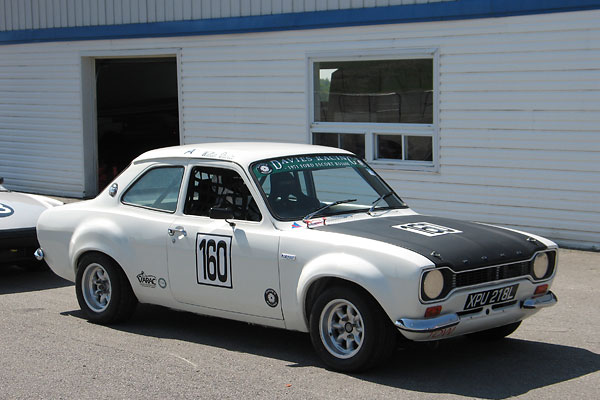
�
Walter Davies' 1971 Ford Escort RS1600 Racecar
� ��
Owner: Walter Davies
�
City: Toronto, Ontario
�
Model: 1971 Ford Escort RS1600
�
Engine: Ford Cosworth 2.0L BDA/G
�
Prepared by: John Dodd�
�
Ford Motorsport Rises to Dominate International Rallying
��
Through the 1960s, Ford partnered with Lotus to offer dual overhead cam cylinder heads,�
close-ratio gearboxes, extensively re-engineered suspensions, uprated brakes, and other�
special features on the Cortina range of mid-sized cars. Ford's sales volume made the�
Cortina eligible for FIA Group 2 homologation, so these hopped-up cars could compete in�
international races. The Lotus twin-cam engine was wonderful, but the Cortina wasn't�
an ideal platform. Especially in rally racing, Cortinas earned a reputation for fragility.�
Ford's works rally team looked for ways to strengthen the Cortina. While testing at Ford's�
Boreham airfield proving ground, a mechanic on the works team spotted salvation: a smaller,�
more nimble, and ultimately much more robust new Ford.�
�
The new model was a subcompact called "Escort". It had been developed to replace Ford's�
"Anglia" model, and it was scheduled to come on line in 1968. The works racing team arranged�
to get a pre-production bodyshell and immediately went to work installing a Lotus twin-cam�
engine.�
�
The Escort was remarkably successful: both in sales and as a rally car. Although the base model�
was a modest little grocery getter, rally racing victories started coming immediately. Ford won�
the World Championship Series for Makes in 1968 and 1969. Ford's little Escort dominated�
the 16,000 mile (25,750 kilometer) 1970 London to Mexico World Cup Rally, an event so tough that�
only 23 cars out of more than 100 finished. Escorts placed first, third, fifth, sixth and eighth.�
(For the Mexico Rally, a simpler and more robust pushrod engine was used.)�
�
Most first generation Escorts were powered by 1.1L and 1.3L versions of Ford's familiar crossflow�
design, but some export models got even smaller engines due to tax and tariff issues. Initially�
at the top of the range, the Escort Twin Cam featured a Lotus developed cylinder head and more�
displacement (1558cc). Then, to capitalize on good publicity from the Mexico rally, an "Escort�
Mexico" special edition featured a robust 1.6L pushrod version of the Kent engine. The Mexico�
special edition continued with strong sales even after a more powerful RS1600 model was introduced.�
RS was an abbreviation for "rally sport".�
�
The Escort RS1600's engine was basically a detuned version of the 1.6L Cosworth BDA (belt drive A-series)�
16-valve, dual overhead cam, aluminum cylinder head powerplant. Ford read FIA's homologation rules�
carefully, then selected a displacement of 1601cc for the RS1600 so they'd cross a class threshold�
and be allowed to race in the 2-liter class. In 1973 Ford updated the standard RS1600 specification�
to 1.8 liters, and in 1974 Ford offered a new Escort RS2000 model which featured a 2.0L Pinto based�
single overhead cam engine which was rated 250bhp and came equipped with a five speed ZF gearboxes.�
Besides full-tilt racing engines, all Twin Cam, Mexico, and Rally Sport Escorts used heavy duty�
"Type 49" bodyshells. AVO started with heavy duty export bodyshells and added brackets for rear�
radius arms, etc. There are detail differences between models in the vicinity of the radiators due�
to clearance issues.�
�
The Rally Sports weren't intended for high volume production, but enough cars were produced that�
they weren't rare either. Ford's Advanced Vehicle Operations (AVO) facility in Aveley, Essex,�
England assembled 1200 Ford Escort RS1600 cars.�
�
According to contemporary magazine reports: price at launch: £1447.�
Acceleration: 0-60mph in 8.3s. Top speed: 114mph. Power: 115hp (DIN) @ 6500rpm.�
Torque: 110lb/ft @ 4500rpm. Displacement: 1601cc (97.68cu in). Bore 80.98mm (3.19in).�
Stroke 77.72mm (3.06in). �
�
Please support the sponsoring companies who make www.BritishRaceCar.com possible, including:
� �
 �
�
�
�
�
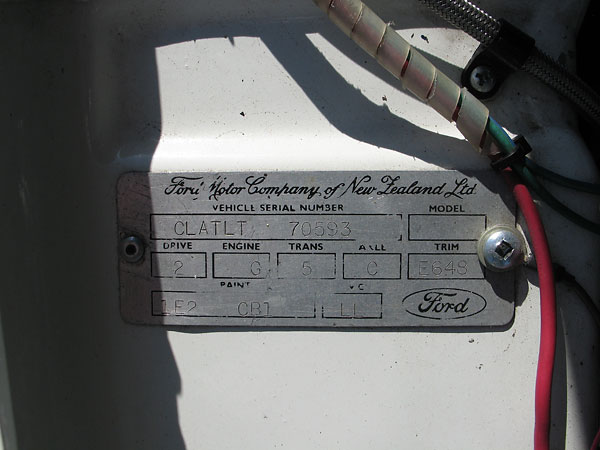
�
Ford Motor Company of New Zealand, Ltd.
�
Vehicle Serial Number: CLATLT 70593, Model: (blank)
�
Drive: 2, Engine: G, Trans: 5, Axle: C, Trim E648,
�
Paint: 1E2 CB1, VC: LL. (Ford)
�
Walter Davies' Escort RS1600
��
Walter Davies acquired his Escort RS1600 in 2005 from rally racer Brent Tiney of New Zealand.�
�
In 1973, Tiney had served as a mechanic on the Woolmark-Ford team which dominated New Zealand's�
Heatway rally. (Heatway was a company that manufactured electric heaters.) Finnish driver Hannu�
Mikkola and co-driver Jim Porter won that rally by a margin of over forty minutes in a works�
supplied Escort RS1600. A promising newer driver in international rallying,�
New Zealand's own Mike Marshall with co-driver Arthur McWatt, piloted a second Woolmark sponsored�
Escort RS1600 to a strong second place finish. The exact identity of Marshall's car is less clear,�
as we'll explain. The team's one-two finish was an especially remarkable feat considering that�
120 cars were entered in this truly international-class rally!�
�
In early 2000, Brent Tiney found a derelict Escort Mk1 racecar and identified it as the very�
car Mike Marshall had raced in the 1973 Heatway rally. The car had obviously had a long racing�
career, but Tiney spent a couple years restoring it to a more original specification before�
putting it up for sale.�
�
By various accounts, Ford's Aveley factory had arranged at least two and possibly as many as five�
cars for the Woolmark-Ford team to choose between for this event. However, Mike Marshall strongly�
preferred a right-hand-drive seating position whereas Hannu Mikkola preferred left-hand-drive.�
Faced with a selection of left-hand-drive cars, Marshall decided to shift fresh "works" components�
onto a bodyshell that he personally owned and would lease back to the team. �
�
Dear reader, if you are even remotely interested in rally racing I would heartily recommend you�
view a spectacular 45 minute documentary on the 1973 Heatway rally. It was produced by NZBC and�
it's available for viewing in a series of four segments here:�
"Rally,�
Like Little Boys in a Man-sized Sport" (TV documentary, circa 1974).�
�
At the very beginning of the second clip, the film-makers show footage of Mike Marshall's�
car coming together. (Engine and transmission go in at 0:36.) Starting about seven minutes into the�
clip you can enjoy a long ride-along in Mike Marshall's car, first at moderate speed and then flat out.�
At about thirteen minutes Mike Marshall describes his approach to powering through corners on loose�
surfaces. At about 2:40 in the third segment a mechanic briefly mentions that the rear suspension�
on Mike Marshall's Escort was different from other RS1600 cars ("...like a car we built about four�
years ago for Roger Clark with the same sort of setup with the links opposed to each other like�
that."¹) Generally, the film makes it quite clear how damaging rally racing tends to be on�
hardware. Very extensive rebuilding occurs, which is why issues of provenance can become especially�
confusing.�
�
Once the RS1600 racecar was imported to Canada, Walter Davies hired John Dodd to convert it from�
rally to road race spec by generally tightening up the suspension, changing transmission and�
differential gear ratios, and replacing the engine's camshafts. Lexan windows were installed,�
and various safety features were updated. �
�
Walter's overbored engine deserves special explanation. It's technically known as a "BDA/G".�
Ford homologated the BDA at 1601cc to go into the up-to-2-liter class. Naturally, racers�
soon began asking "Why not bore this block out to 2 liters? What's the point of being at�
the bottom of the 1601-2000cc displacement bracket when we could be at the top?" So Ford�
and others started developing bored-out versions of the BDA motor specifically for use�
in Escort rally cars. The challenge lay in increasing the bore without hitting the engine's�
water jacket or oil galleys. One of the first specialist machinists to successfully master�
the details of this was Brian Hart. Hart began offering a 1975cc (90mm bore) specially�
modified version of the Ford engine block in October 1972. �
�
The Vintage Automobile Racing Association of Canada (VARAC) cuts off eligibility at 1972.�
In other words, cars and their respective key components must have been available for purchase�
by the end of that calendar year. By VARAC's rules, an Escort RS1600 may use a 90mm bore�
engine block because it was available in late 1972 from Brian Hart, but it may only be�
used in combination with a then-available Cosworth BDA "1.6 liter" cylinder head. Cosworth�
didn't produce a 90mm "2 liter" version of their cylinder head until 1973 when Ford started�
producing their own 2 liter engine blocks. (The two liter version of the BDA then came to be�
known as the BDG.) Oddly enough, the BDA/G combination works pretty well!�
�
 �
�
�
�
Features and Specifications
�| Engine: | �Ford Cosworth two liter engine.�
Brian Hart engine block, with 90mm bore.�
16-valve Cosworth BDA cylinder head.�
Separate cam carrier.�
Dual Weber 48 DCOE carburetors.�
Gas flowed intake manifold.�
Mallory Unilite distributor.�
Mallory chrome Blaster 2 ignition coil with ballast resistor.�
Magnecor KV35 Competition spark plug wires.�
MSD Soft Touch rev-limiter, chipped at 8,600rpm.�
Dry sump lubrication system, including 5-port oil pump.�
Fram PH43 oil filter on a Mocal filter mount.�
| �
| Cooling: | �copper and brass downflow radiator.�
13-row oil cooler. | �
| Exhaust: | �custom 4-into-1 header. | �
| Transmission: | �Quaife Rocket 4-speed dog-ring gearbox.�
AP Racing 2-plate sintered bronze clutch (just for getting the car moving from a stop.) | �
| Rear axle: | �Ford Atlas axle housing.�
ZF limited slip differential.�
3.9:1 crown wheel and pinion.�
Fully floating axles. | �
| Front Susp.: | �reinforced strut towers and Monte Carlo bar.�
RS struts with 350#/in springs and with Bilstein shock absorber inserts.�
Compression strut system.�
Anti-roll bar.�
Rack and pinion steering. | �
| Rear Susp.: | �4-link plus Panhard rod.�
Bilstein shock absorbers, "turreted" (i.e. re-mounted more nearly vertical).�
Leaf springs mounted on "slipper" bearings. | �
| Brakes: | �(master) dual master cylinders with bias bar and remote adjuster, and Lockheed remote reservoirs. � (front) Wilwood calipers and vented rotors, � (rear) Girling calipers and solid rotors. | �
| Wheels/Tires: | �genuine Minilite aluminum 8-spoke wheels (13x7).�
Toyo Proxes RA1 (206/60R13 86V) tires. | �
| Electrical: | �no charging system. | �
| Instruments: | �(left to right)�
Smiths fuel level guage (E-F),�
MSD Ignition shift light,�
Racetech water temperature gauge (30-110C),�
Racetech dual oil pressure (0-100psi) and oil temperature gauge (40-140C),�
Smiths tachometer with telltale (0-10,000rpm).�
| �
| Fuel System: | �ATL SP122C 22 gallon fuel cell (for Enduro races.)�
Twin Facet (Bendix style) electric fuel pumps.�
Filter King fuel filter.�
| �
| Safety Eqmt: | �Schroth Racing 6-point cam-lock safety harness (driver side).�
Willans 6-point cam-lock safety harness (passenger side).�
Racetech 100W racing seats.�
Wink mirror.�
Lifeline Zero 2000 foam based centralized fire suppression system.�
Sparco quick release steering wheel hub on a Sparco suede covered steering wheel.�
| �
Engine Installation
��
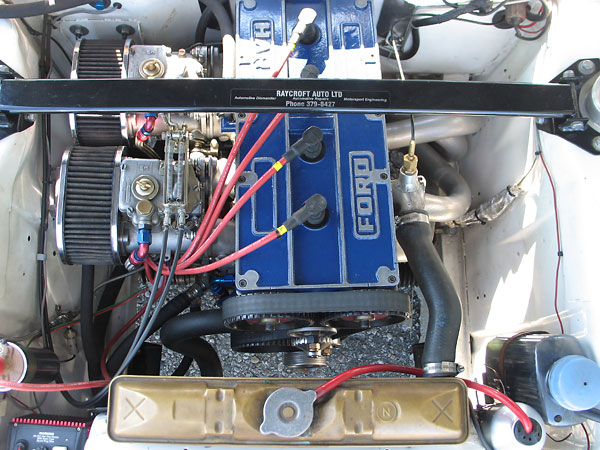
�
Ford engine with Brian Hart prepared engine block (90mm bore) and
�
Cosworth BDA 16-valve, dual overhead cam cylinder head.
�
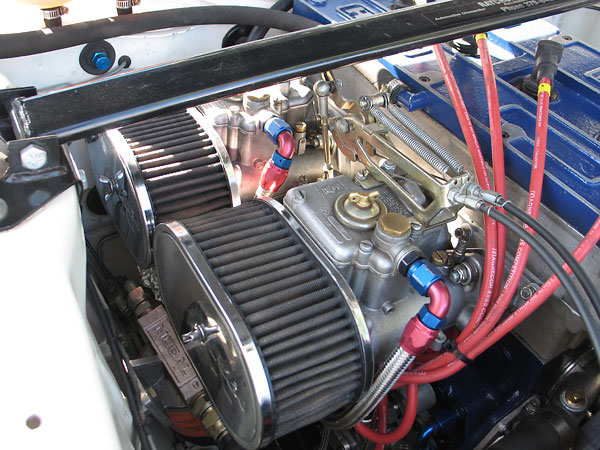
�
Dual Weber DCOE carburetors with K&N gauze air filters.
�
(The RS1600 model came standard with twin Dellorto DHLA 40 carbs.)
�
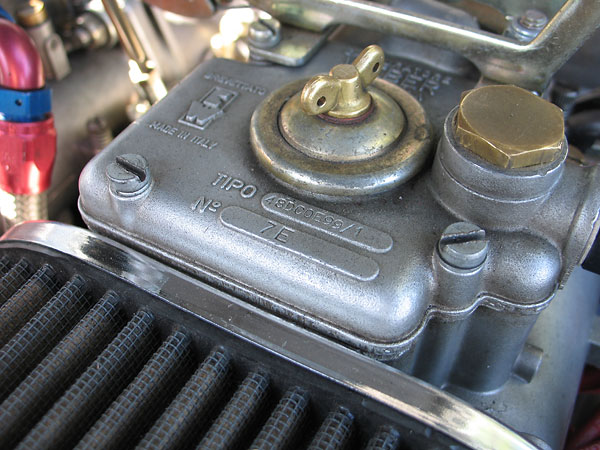
�
Weber carburetor Tipo 48DCOE99/1 No. 7E.
�
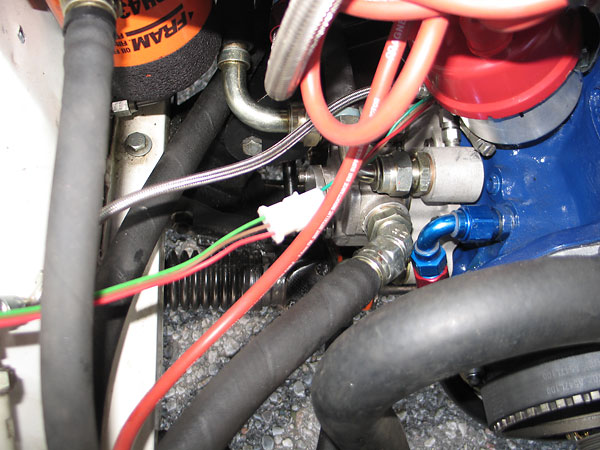
�
Top right: Mallory Unilite distributor. Center: oil pump for dry sump lubrication system.
�
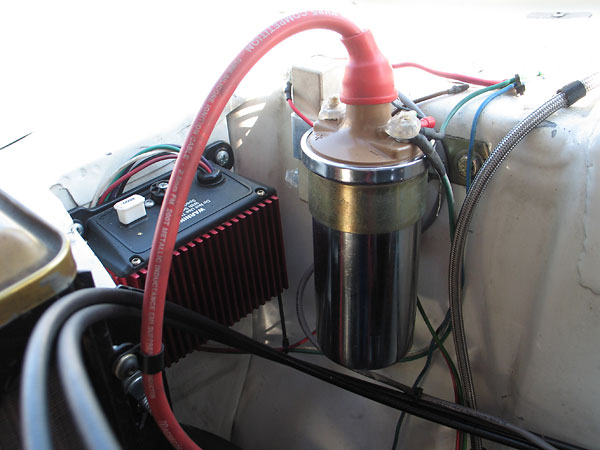
�
Left: MSD Soft Touch rev-limiter, chipped at 8,600rpm.
�
Right: Mallory chrome Blaster 2 ignition coil with ballast resistor.
�
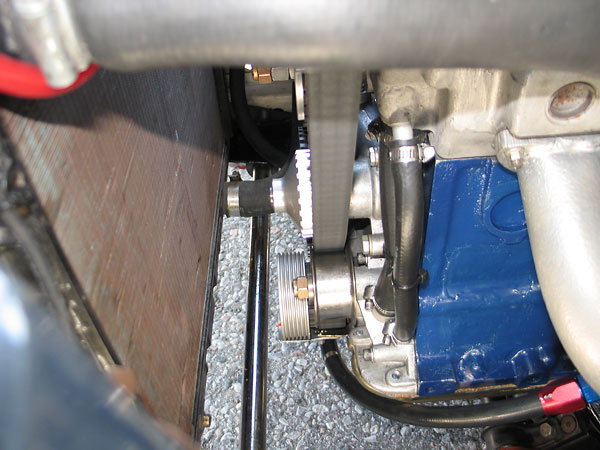
�
Copper and brass downflow radiator.
�
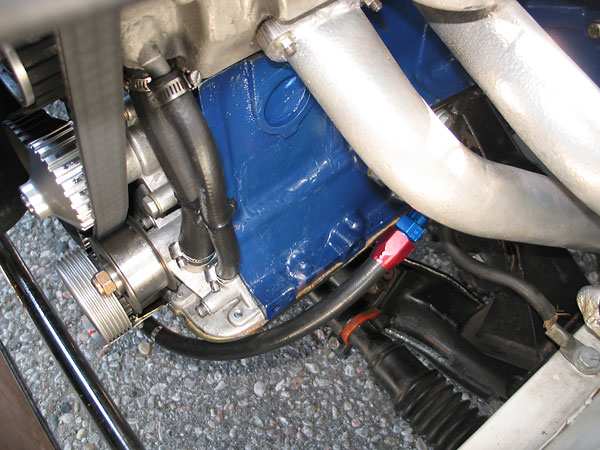
�
With cylinder bore increased to 90mm, there's no room for cross-block oil galleys. The traditional
�
solution is to use a 5-port oil pump and route an external oil hose around the front of the engine.
�
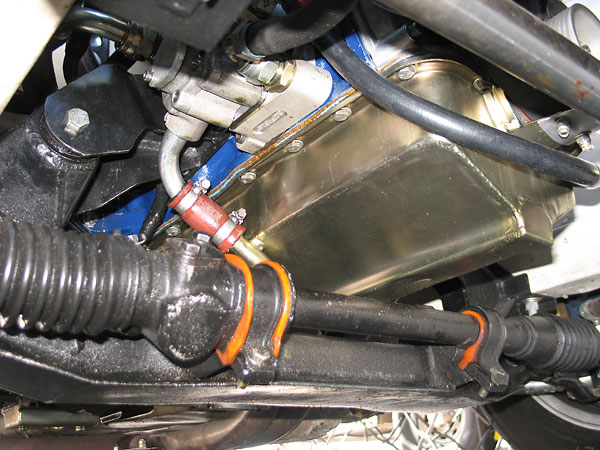
�
Details of the dry sump lubrication system: pump and oil pan.
�
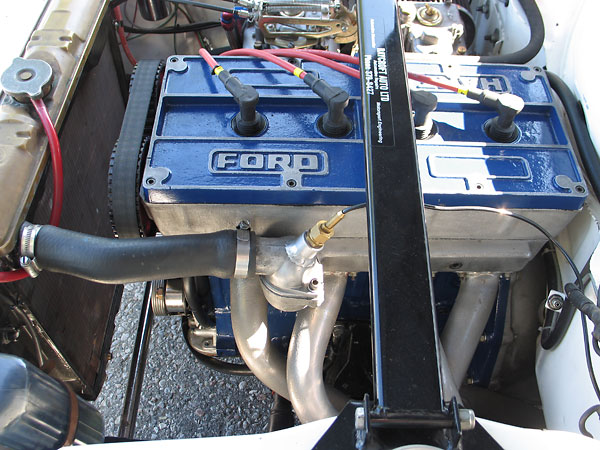
�
Custom 4-into-1 exhaust header.
�
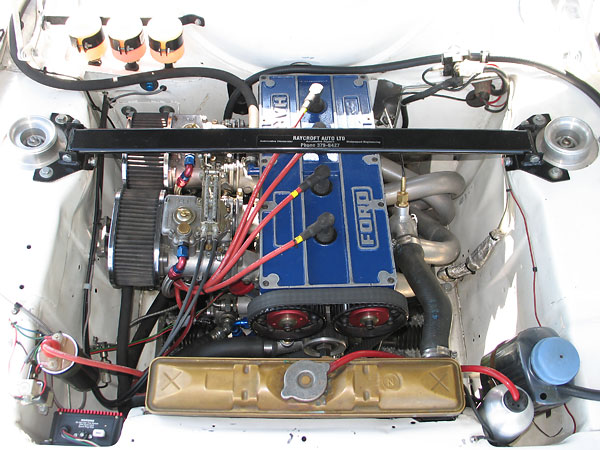
�
A Monte Carlo bar spans and braces between the two MacPherson strut towers.
�
(Raycroft Auto Ltd. is Opawa, Christchurch, New Zealand specializes in Ford Escorts.)
�
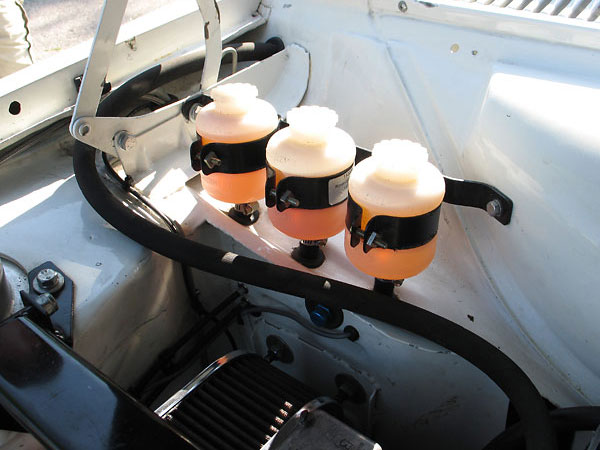
�
Lockheed brake and clutch master cylinder fluid reservoirs.
�
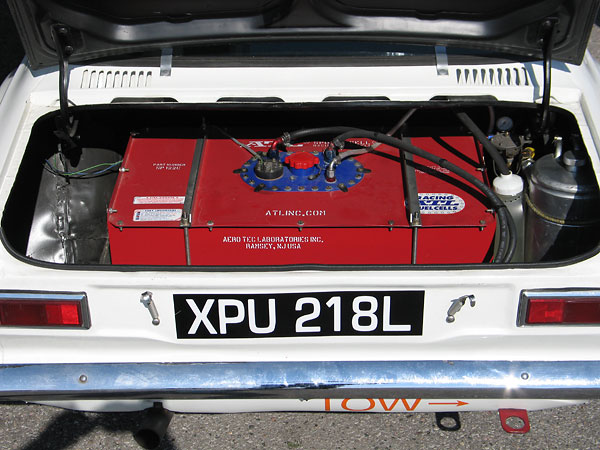
�
ATL SP122C 22 gallon fuel cell (for Enduro races.)
�
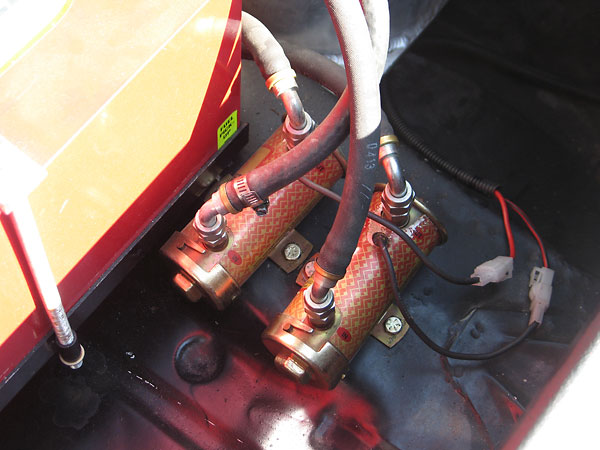
�
Twin Facet (Bendix style) electric fuel pumps.
�
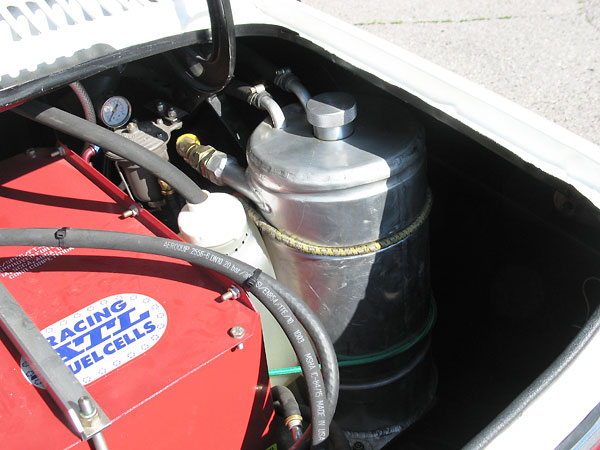
�
Top left: Filter King fuel filter. Right: oil reservoir for dry sump lubrication system.
�
�
Front Suspension / Etc.
��
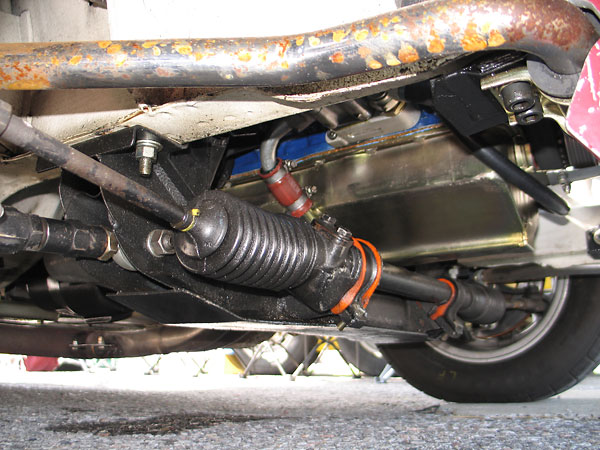
�
Ford Escorts came standard with rack and pinion steering.
�
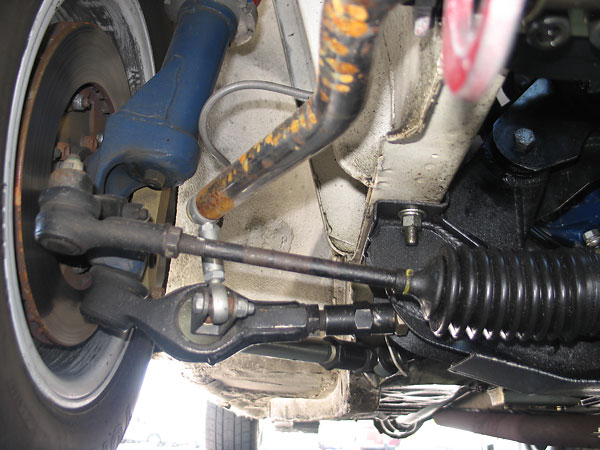
�
As originally designed by Ford, the front anti-sway bar served double-duty as the front half of the
�
control arms, connecting directly to eyes in the forged lower links. On Walter's RS1600, separate
�
radius rods have been added and the anti-sway bar is connected in a more traditional manner.
�
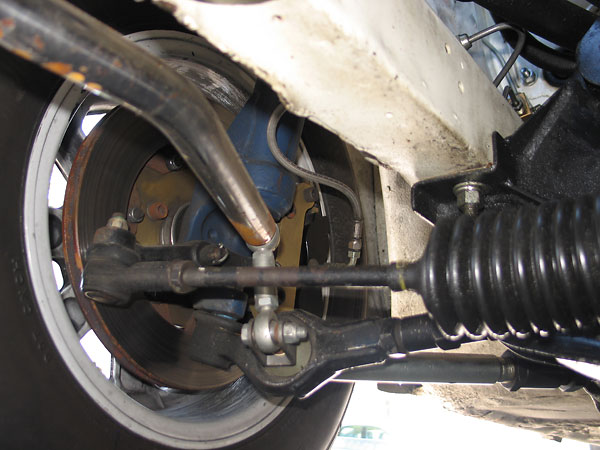
�
Ford Escort RS1600's have a 29.7ft (9.054m) turning circle.
�
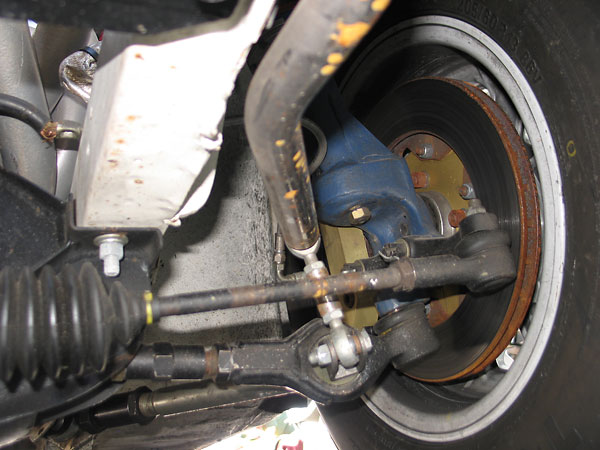
�
Upgraded brakes: Wilwood calipers and vented rotors.
�
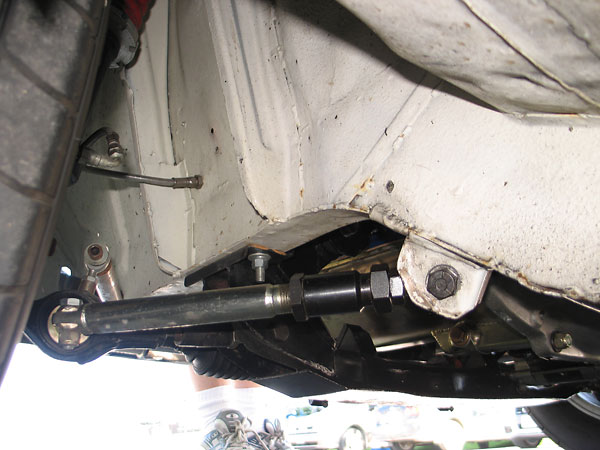
�
Radius rods added to the front suspension alter its geometry.
�
�
IMPORTANT ANNOUNCEMENT
�
BritishRaceCar.com will have to cut back plans for continued growth if we can't find more financial support.
�
If you like what you've found here, and you want to see more, please click here and follow the instructions.
�
Readers like you keep BritishRaceCar.com online and growing through voluntary financial contributions.
�
Rear Suspension
��
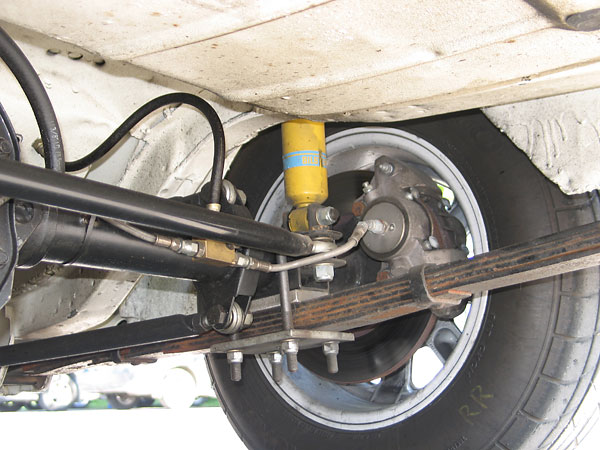
�
Semi-elliptic leafsprings have been clamped tightly to the axle even though the car
�
has been fitted with both upper and lower trailing links plus a Panhard rod.
�
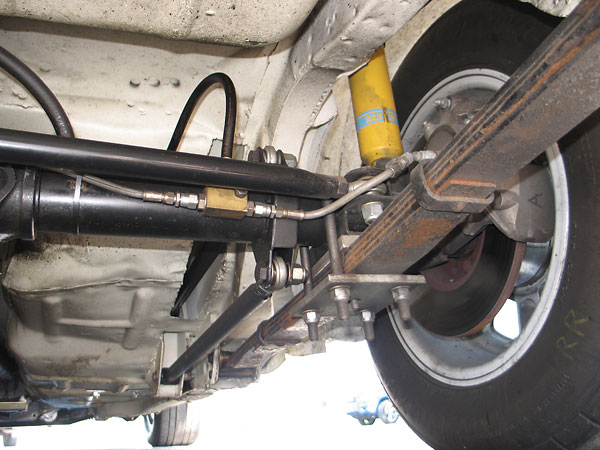
�
Girling calipers and solid rotors. (The RS1600 model came standard with 9" drum rear brakes.)
�
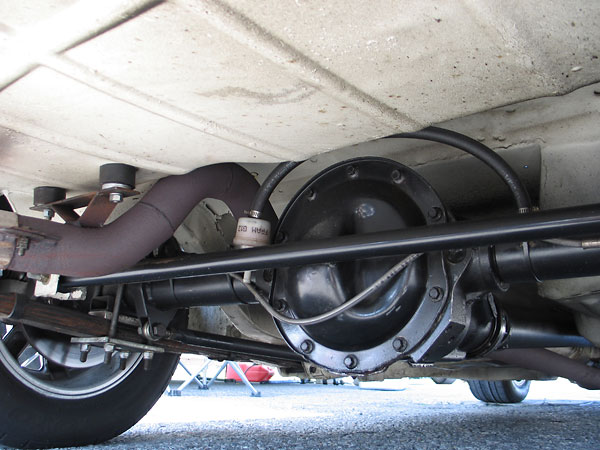
�
Ford Atlas housing, ZF limited slip differential, 3.9:1 crown wheel and pinion, and fully floating axles.
�
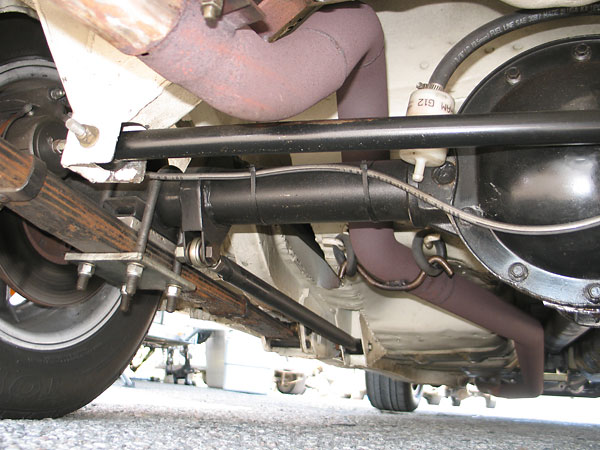
�
Long, level Panhard rod and its attachment to the body (at left).
�
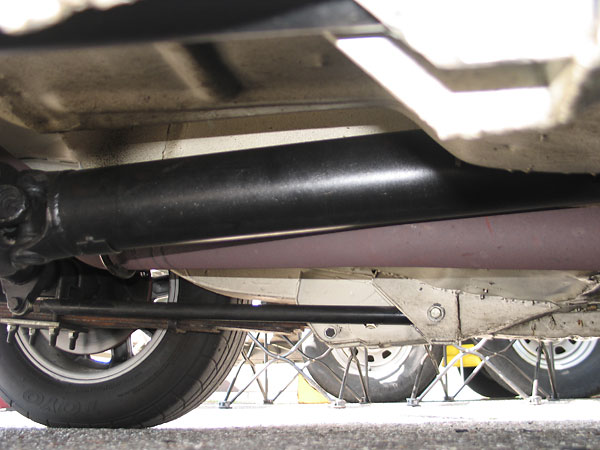
�
Lower radius rods in side view.
�
�
Interior
��
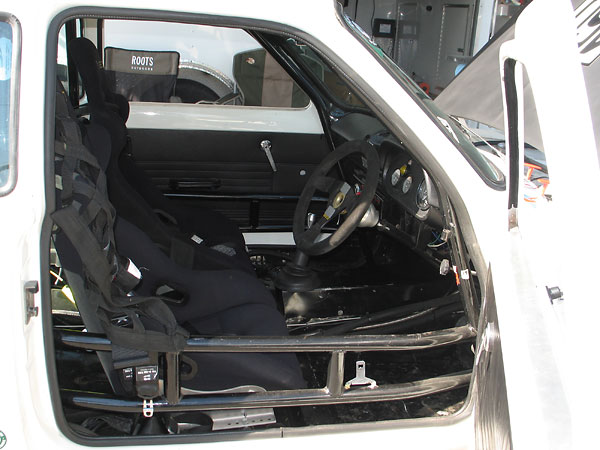
�
This is what the interior of a classic rally car looks like. Note particularly the
�
side intrusion bars, which span both door openings.
�
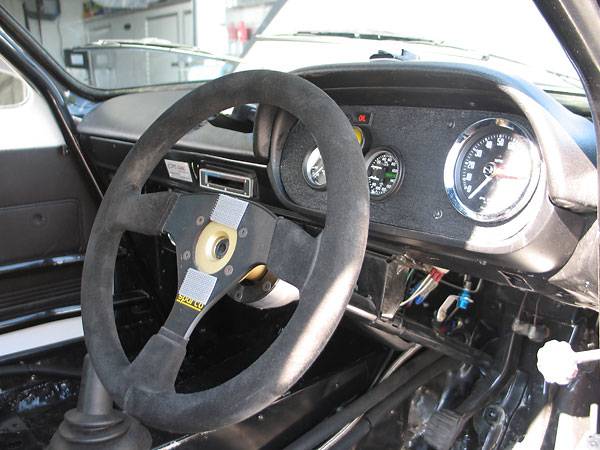
�
Sparco suede covered steering wheel.
�
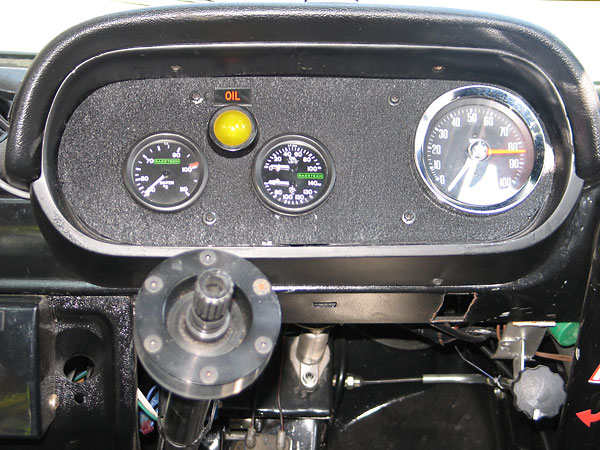
�
Racetech water temperature gauge (30-110C) and dual oil pressure (0-100psi) / oil temperature
�
gauge (40-140C). Smiths tachometer with telltale (0-10,000rpm).
�
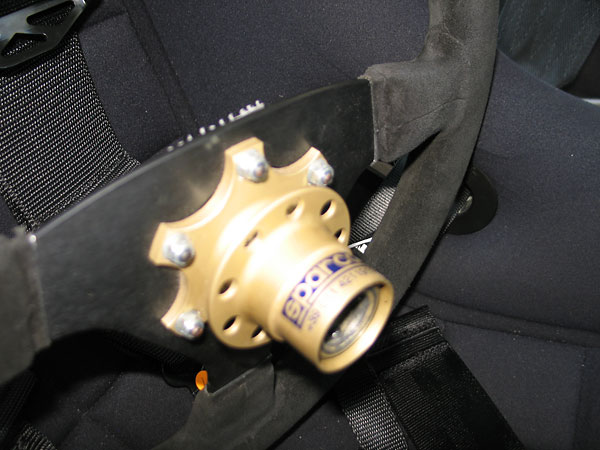
�
Sparco quick release steering wheel hub.
�
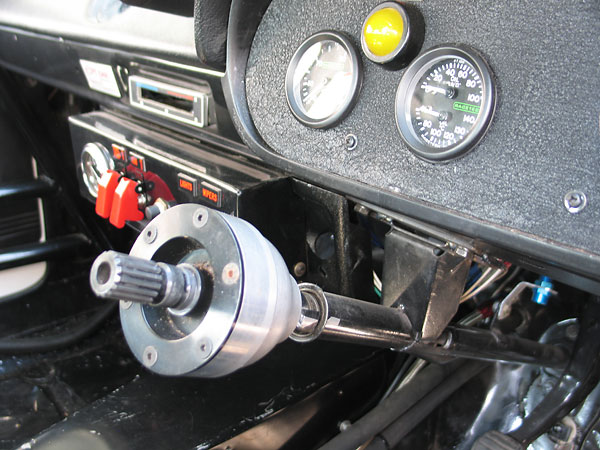
�
Splined connection on the steering shaft. (It appears an adapter has been left in place for
�
bolting-on a steering wheel without quick release hub. This would restore a period correct
�
appearance. Most racers now consider quick release hubs to be valuable safety equipment.)
�
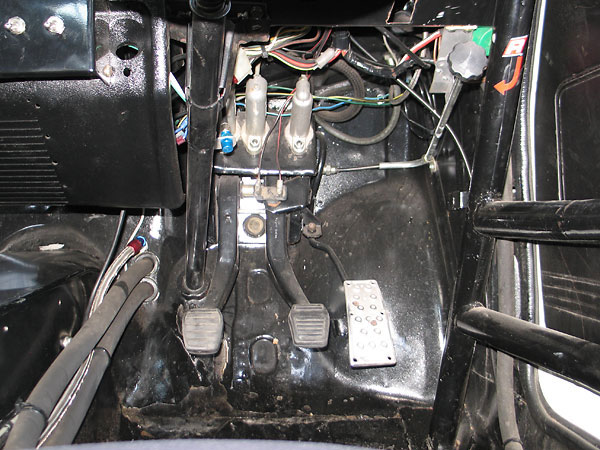
�
Pedals and Girling master cylinders. Note brake bias adjustment knob at upper right.
�
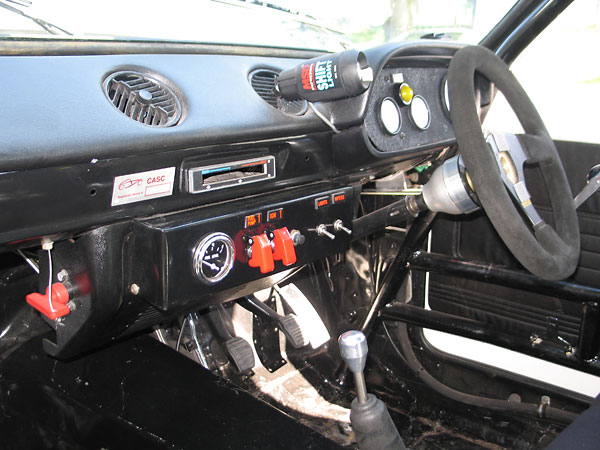
�
Switches (left to right): battery disconnect, fuel pump, ignition, starter (pushbutton), lights, and wipers.
�
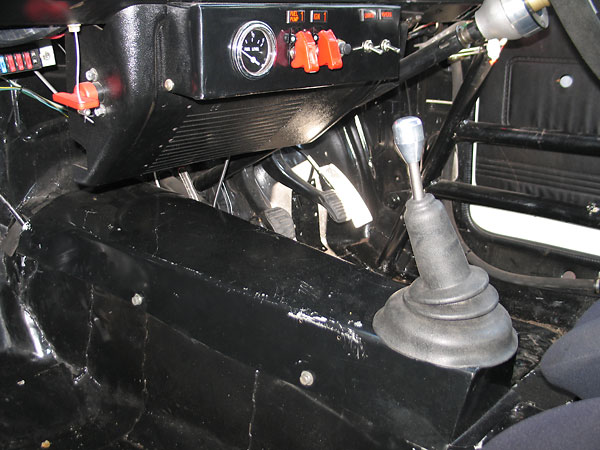
�
Gear selector for the Quaife Rocket 4-speed dog-ring gearbox. (Note that the
�
transmission tunnel has been modified to make room for it.)
�
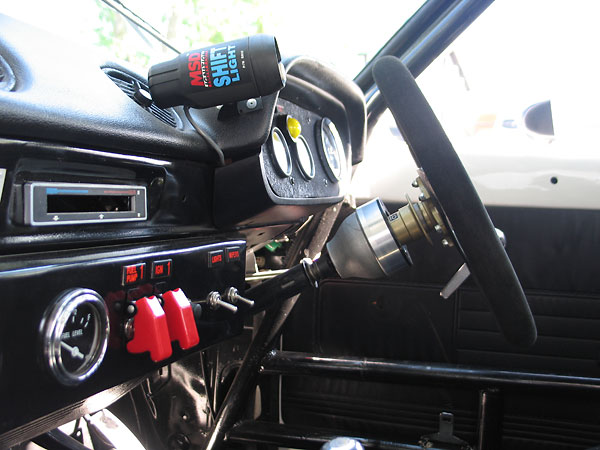
�
MSD Ignition shift light.
�
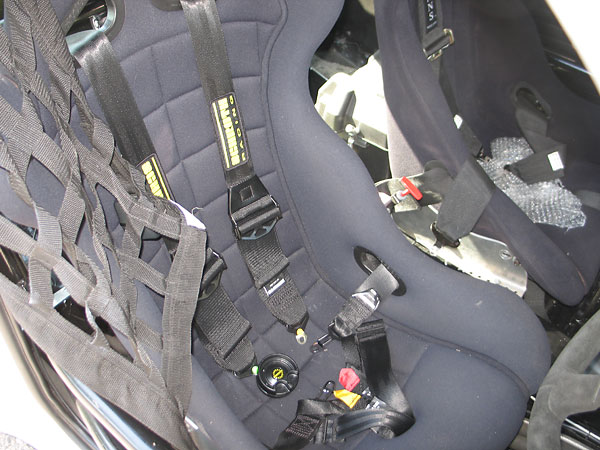
�
Schroth Racing 6-point cam-lock safety harness.
�
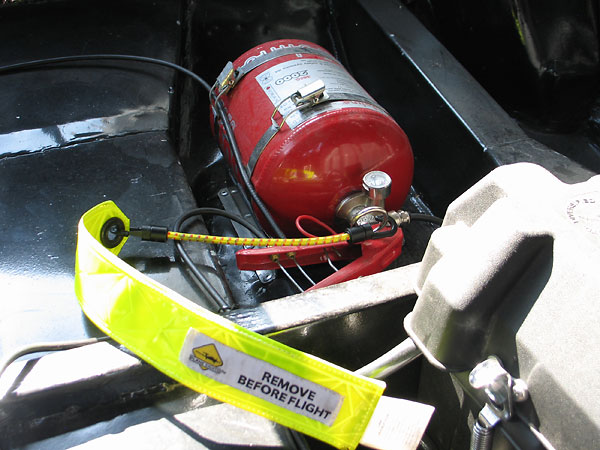
�
Lifeline Zero 2000 foam based centralized fire suppression system.
�
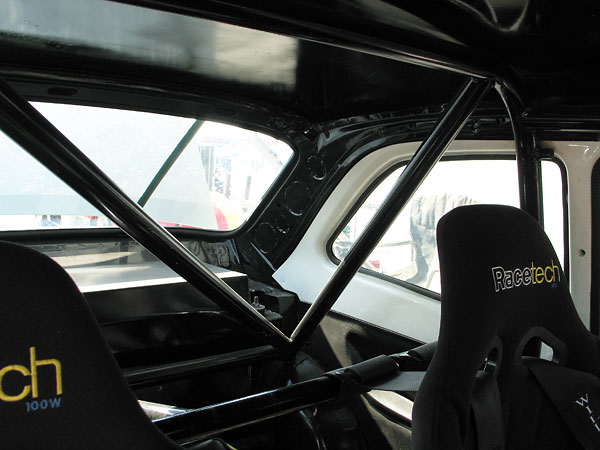
�
Roll cage construction details.
�
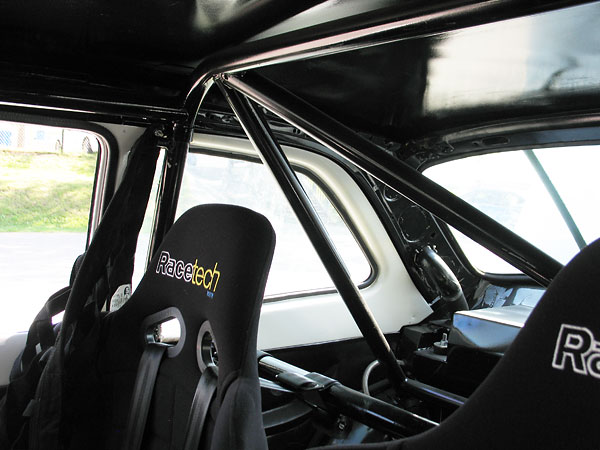
�
Racetech 100W racing seats. (The "w" indicates that this is the wide base version.)
�
Racetech seats are made in New Zealand.
�
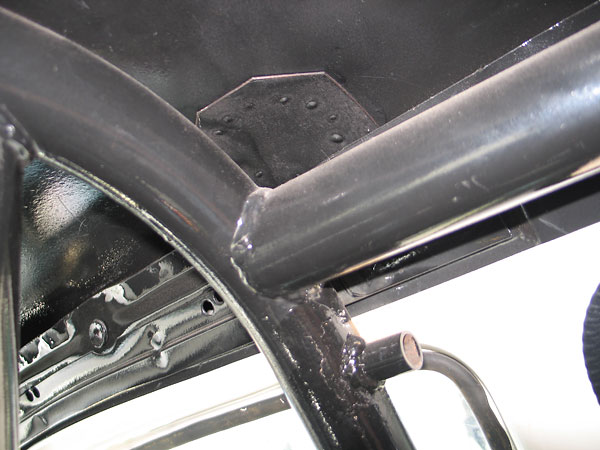
�
To weld completely around the circumference of this connection, an access hole was cut in the roof.
�
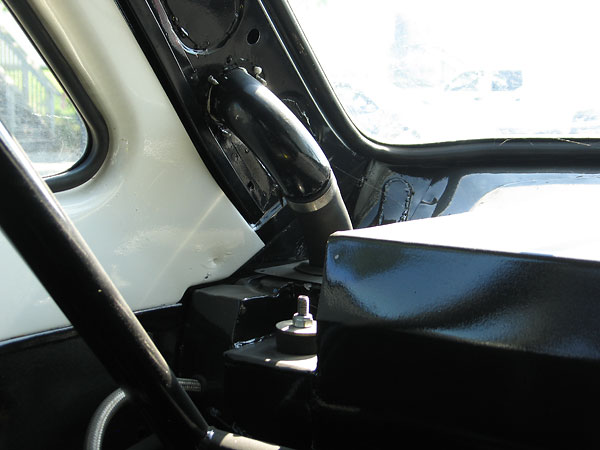
�
Rear shock absorber connection. (Behind: fuel filler detail.)
�
�
Exterior
��
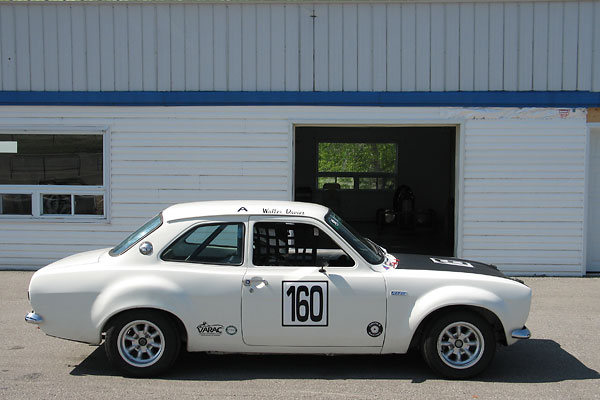
�
Escort was Ford's first entirely non-U.S. model to surpass the two-million-car production mark.
�
Initially, the Escort was only available as a 2-door, but months later 3-door "estate" and panel
�
van versions were added. Ford finally introduced a 4-door version in 1969.
�
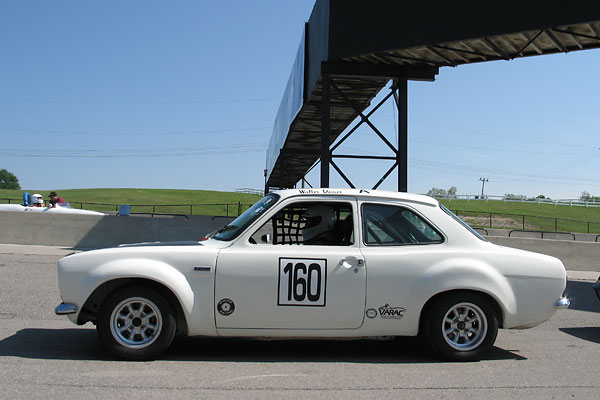
�
Most first-gen Escorts were powered by 1.1L and 1.3L versions of Ford's familiar crossflow design.
�
The Escort Twin Cam featured a Lotus developed cylinder head and more displacement (1558cc).
�
The Escort Mexico special edition featured a robust 1.6L pushrod version of the Kent engine.
�
Then came the RS models, with 1.6L and 1.8L Cosworth engines and finally a 2.0L Pinto engine.
�
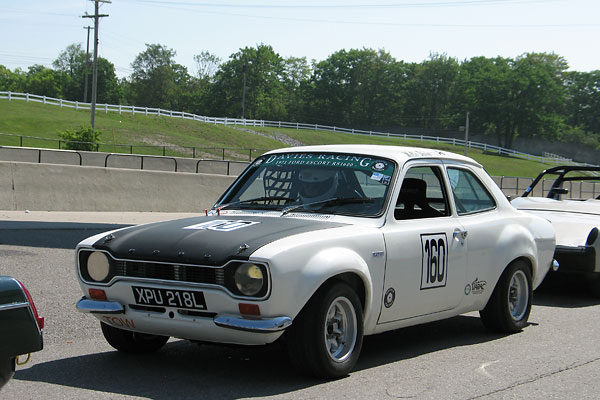
�
Escort Mk1 was campaigned by Ford "works" teams from 1968 through 1975. In terms of competition
�
it filled and largely dominated the era between the Mini Cooper / Cooper S (raced by works teams
�
from 1962-70) and the introduction of the Lancia Stratos (1974-81) and Fiat 131 Abarth (1976-81).
�
The Escort Mk1 was replaced by the Escort Mk2, which was raced by works teams from 1975-81.
�
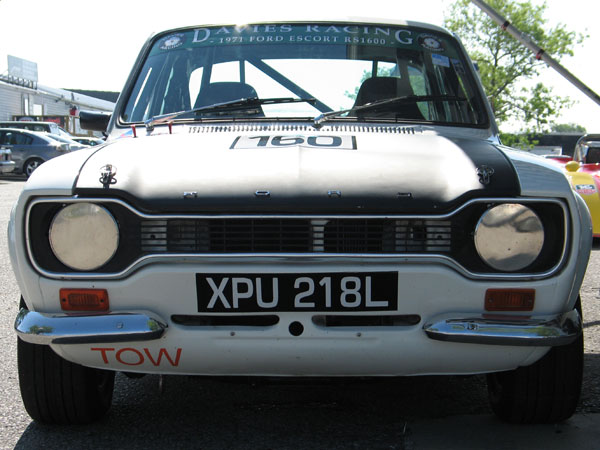
�
�
Ford Escort Mk1: Coke bottle styling and a dog bone grille.
�
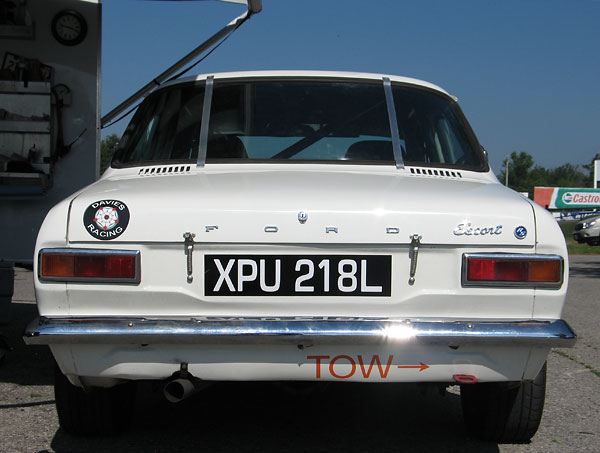
�
Export style taillamp clusters and original style bumpers have been retained.
�
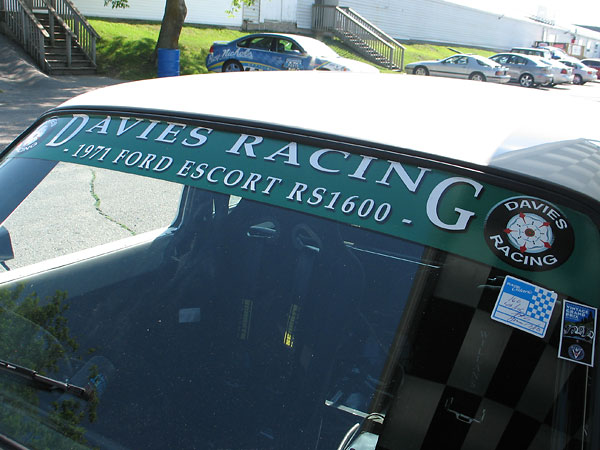
�
Windshield visor film: Davies Racing - 1971 Ford Escort RS1600
�
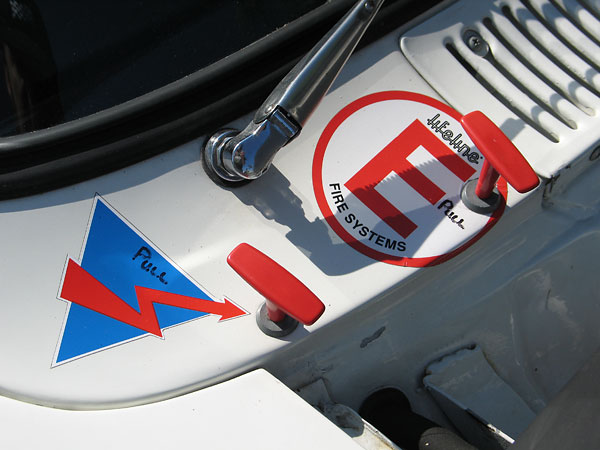
�
Separate switches for disconnecting the battery and triggering the onboard fire suppression system.
�
(Walter's battery disconnect switch also shuts off the engine's ignition system.)
�
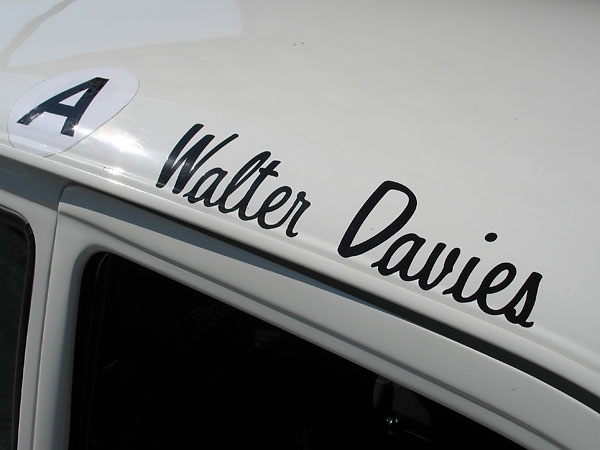
�
Driver: Walter Davies
�
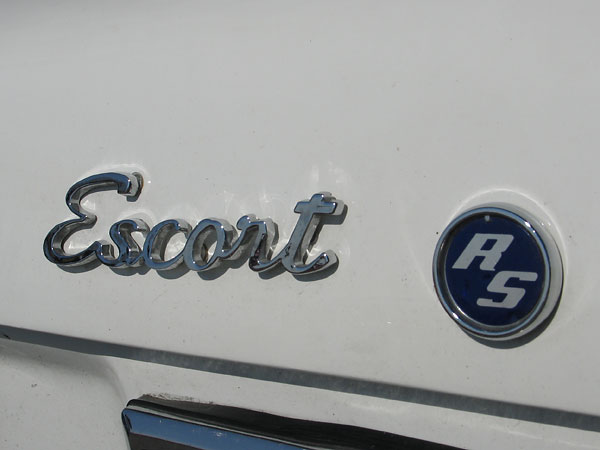
�
Escort RS badges.
�
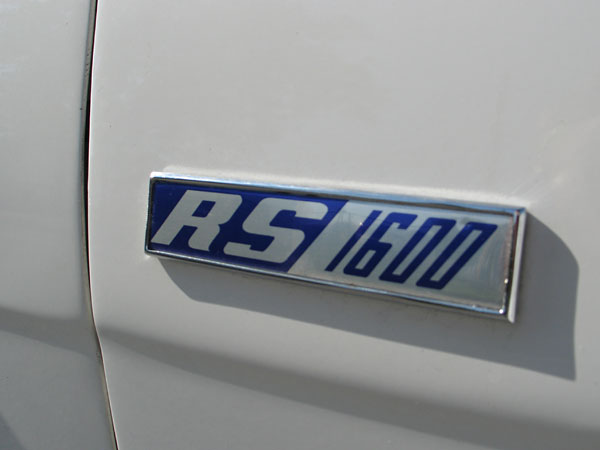
�
RS1600 badge.
�
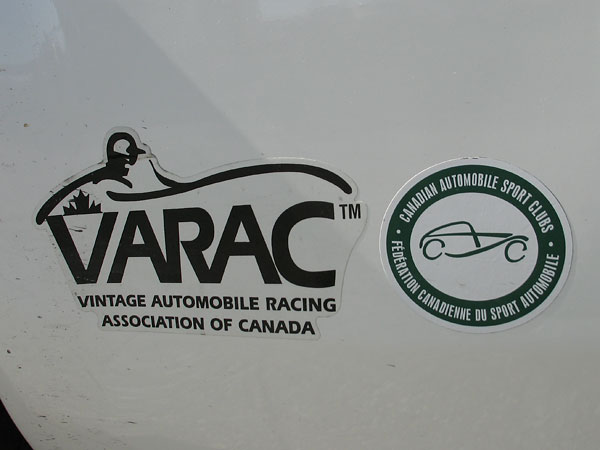
�
VARAC: Vintage Automobile Racing Association of Canada
�
(Walter has served as VARAC's President since 2007.)
�
CASC: Canadian Automobile Sport Clubs
�
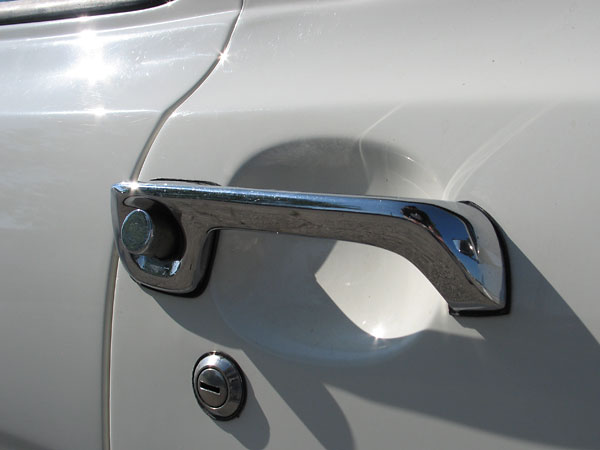
�
Ford Escort door handle detail.
�
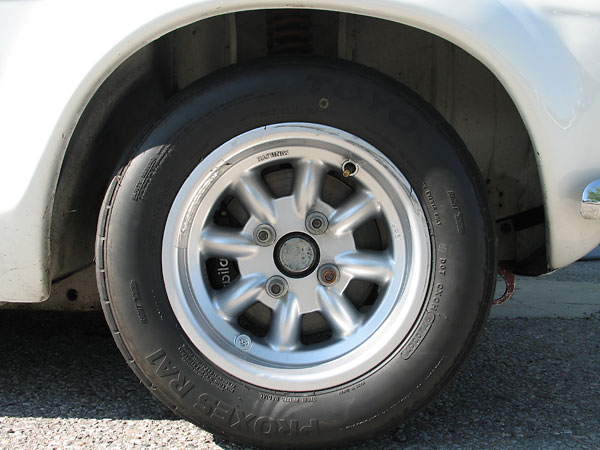
�
Genuine Minilite aluminum 8-spoke wheels (13x7).
�
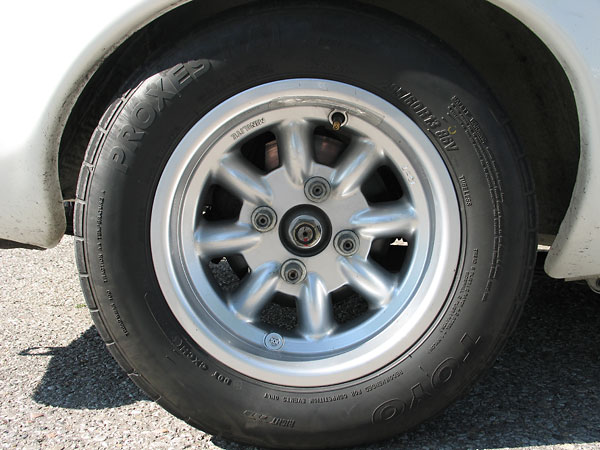
�
Toyo Proxes RA1 (206/60R13 86V) tires.
�
| Notes: | |||||||
| (1) | � Generally, voices in the NZBC interviews weren't attributed to specific people. I believe� that the voice in this clip belonged to Mick Jones who was Chief Mechanic at Boreham.� Please contact this writer if you can confirm of refute...� | ||||||
�
�
All photos shown here are from June 2010 when we viewed the car at VARAC's 31st International Vintage Festival�
at Mosport International Raceway, near Toronto Ontario. Photos by Curtis Jacobson for BritishRaceCar.com, �
copyright 2011. All rights reserved.
�
| If you liked this article, you'll probably also enjoy these: | �|||||
 | �
Terry Milnes '66 Austin Mini | �
 | �
Bob Polak '69 Mini Marcos | �
 | �
Walter Davies '79 Lola T492 | �
| You're invited to discuss anything you've seen here on The British Racecar Motorsports Forum! | �|||||
�
Notice: all the articles and almost all the photos on BritishRacecar.com are by Curtis Jacobson.
�
(Photos that aren't by Curtis are explicitly credited.) Reproduction without prior written permission is prohibited.
�
Contact us to purchase images or reproduction permission. Higher resolution images are optionally available.
�

 �
�